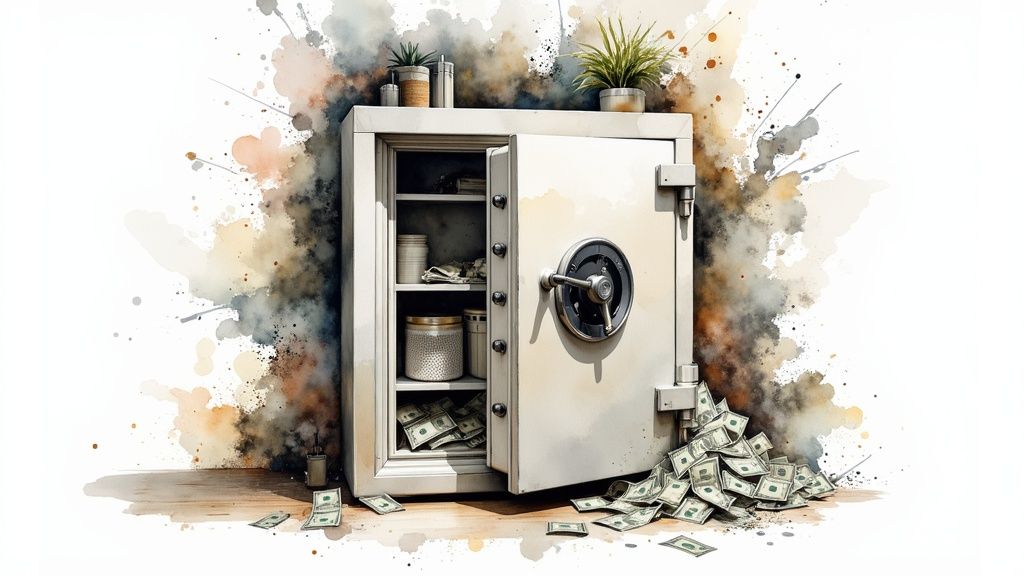




The security of cryptocurrency wallets remains a critical concern amid the ongoing threats faced by investors and users. While major exchange hacks grab headlines, the reality of wallet security involves understanding specific risks and taking practical steps to protect assets. A clear grasp of actual threats, rather than media sensationalism, enables better security decisions.
Cryptocurrency theft methods continue to advance and adapt. For instance, phishing has emerged as the primary vector for losses in 2024, with criminals stealing over $2.3 billion through social engineering attacks rather than technical exploits. This shift highlights why users must develop strong verification habits for all online cryptocurrency interactions.
The data tells an interesting story - while the total value stolen dropped 54.3% in 2023, the number of incidents increased. This pattern shows criminals moving toward smaller but more frequent attacks. The fact that compromised private keys caused 75% of losses in early 2024 emphasizes the fundamental importance of secure key storage and management.
Recent trends put more responsibility on individual users to protect their assets. The decline in DeFi protocol hacks during 2023 shows how focused security measures can reduce risks significantly. For individual wallet holders, this means consistently using strong passwords, two-factor authentication, and keeping software updated - basic but essential practices that create strong protection.
The core security features of blockchain technology provide important protections for cryptocurrency wallets. Take Ethereum, which has over one million validators staking more than 33.8 million ETH as of September 2024. This massive decentralized network makes it extremely difficult to manipulate transactions or alter records. However, vulnerabilities in smart contract code still pose risks, making ongoing security audits essential. Understanding your chosen blockchain's specific security model helps build an effective protection strategy.
The cryptocurrency security landscape demands constant vigilance against new threats along with disciplined security practices. From careful private key management to strong anti-phishing measures, each security step strengthens your overall protection. With informed, proactive effort, users can effectively safeguard their cryptocurrency holdings despite evolving risks.

Private keys are fundamental to cryptocurrency security, acting as the master passwords that control access to your digital assets. Recent data shows that compromised private keys caused 75% of cryptocurrency losses in early 2024, highlighting just how critical proper key management is. Without careful protection of these keys, you risk permanently losing access to your funds.
Finding the right balance between security and accessibility is key to effective private key management. While storing keys completely offline provides maximum protection, it can make regular transactions cumbersome. For funds you access frequently, using a "hot wallet" with strong passwords and two-factor authentication makes sense. However, significant holdings should be kept in "cold storage" solutions like hardware wallets, which keep private keys safely offline and away from potential online threats.
Hardware wallets provide exceptional security by physically isolating your private keys from internet-connected devices. This separation creates a strong defense against hackers - even if your computer is compromised, your keys remain protected. Since these devices require manual confirmation for all transactions, they add an essential layer of security. For investors with substantial cryptocurrency holdings, integrating a hardware wallet is one of the most effective ways to protect assets.
Think of private key backups like spare house keys - essential for preventing lockouts, but equally important to keep secure. When creating backups, avoid digital storage which could be vulnerable to hacking. Instead, use physical methods like engraved metal plates or handwritten copies stored in multiple secure locations. Learn more in our article about How to master.... This redundancy protects against both accidental loss and localized disasters. Good security requires understanding the importance of reliable backups and maintaining them consistently.
Security lapses can affect even experienced cryptocurrency holders. Using the same password across multiple platforms creates vulnerability - if one account is breached, all others become exposed. Skipping software updates also introduces risk by leaving known security flaws unpatched. Phishing attacks continue to pose a major threat, making it essential to verify the authenticity of any website or communication before entering private keys or seed phrases.
Following these practices diligently helps protect your cryptocurrency assets against current threats. Remember that wallet security requires ongoing attention and updates as new risks emerge.

Securing your cryptocurrency requires more than basic password protection and hardware storage. With phishing scams causing over $2.3 billion in losses in 2024, developing a strong defense strategy has become essential for protecting digital assets. Understanding how these attacks work and implementing preventive measures can help safeguard your holdings.
Phishing attacks manipulate human psychology by creating false urgency or fear to override careful thinking. For example, scammers often send emails warning that your account has been compromised, directing you to click a link to "verify" your information. This link actually leads to a fake site designed to steal your login details. Another frequent scheme involves fake cryptocurrency giveaways or airdrops that require small upfront fees or wallet access. These scams succeed by appealing to the universal desire for quick profits.
Careful verification forms the foundation of wallet security. Every link, email, and message about your cryptocurrency deserves thorough scrutiny. Before entering any login information, check the URL for subtle misspellings or variations that could indicate a fake site. When receiving unexpected communications, even from seemingly legitimate sources, contact the sender through official channels to confirm authenticity. This simple step can prevent many common phishing attempts.
Creating a custom security system adds vital protection against phishing. Start by making a whitelist of trusted cryptocurrency platforms and contacts - then only interact with communications from these approved sources. Also implement two-factor authentication (2FA) wherever available. While not perfect, 2FA creates an important additional barrier that makes successful attacks much more difficult. This layered approach helps protect your assets even if passwords become compromised.
Understanding the psychological tactics of phishing matters as much as technical safeguards. Scammers typically manufacture artificial time pressure to force quick, unwise decisions. They may claim an offer expires soon or that your funds face immediate risk. Counter these tactics by pausing to evaluate situations objectively. Be especially wary of emotional manipulation, promises of unrealistic returns, or deals that seem too good to be true. This psychological awareness strengthens your defenses against social engineering attacks.
By combining technical protections like 2FA and thorough verification with an understanding of scammer psychology, you can build strong defenses against phishing. Stay alert and maintain healthy skepticism - these are your best tools for protecting cryptocurrency from evolving threats. Securing your assets requires ongoing education and adaptation as new risks emerge.

While individual wallet security is essential, the underlying blockchain technology provides powerful security features that protect your cryptocurrency assets. To make informed decisions about protecting your holdings, it's important to understand these security features and evaluate different blockchain platforms based on their security architecture rather than just their popularity.
The security of different blockchain networks varies significantly based on several key factors. The consensus mechanism, number of network validators, and level of decentralization all play critical roles in determining how well protected your cryptocurrency wallet will be. For instance, Ethereum with its millions of validators offers much stronger security against attacks compared to networks with smaller, more centralized validator groups. This wide distribution of validators makes it extremely difficult for bad actors to manipulate transactions or alter the blockchain's record.
The validators on a blockchain network serve as security guardians by verifying transactions and maintaining the integrity of the system. Similar to how a large, diverse jury provides more balanced judgment than a small group, having more validators creates a more robust and secure network. When selecting platforms to store your cryptocurrency assets, examining the health and decentralization of the validator network helps ensure better protection of your holdings.
Many blockchain platforms use smart contracts, especially for DeFi applications. However, flaws in smart contract code can create serious vulnerabilities. Past incidents have shown how hackers can exploit poorly written contracts to steal funds from DeFi protocols. Before using any smart contract-based platform, look for evidence of rigorous security audits and ongoing code reviews. Understanding exactly how the smart contracts work also helps you avoid unexpected risks.
Finding the optimal blockchain requires carefully weighing your priorities around security versus other factors like speed and scalability. Research the security track record, development transparency, and security practices of different platforms. Key considerations include any past security breaches, how openly security issues are disclosed and addressed, and the broader community's commitment to maintaining strong security standards. The blockchain you select forms the foundation of your cryptocurrency wallet's security.
Just as banks employ multiple security measures like vaults, alarms, and guards, protecting your cryptocurrency requires several layers of defense working together. When you combine multiple security practices, even if attackers breach one layer, your assets remain protected by the others. Let's explore how to build an effective security system.
The key to cryptocurrency wallet security lies in strategically layering different protective measures. For instance, start with a hardware wallet to store private keys offline, then add strong passwords, two-factor authentication (2FA), and regular software updates. Each additional layer multiplies the difficulty for potential attackers, as they must overcome multiple independent security barriers.
For those seeking institutional-grade protection, Hardware Security Modules provide a specialized environment for managing cryptographic keys. These devices generate and store keys in tamper-resistant hardware, similar to a high-security digital vault. While traditionally used by organizations, HSMs are becoming more accessible to individual investors with substantial holdings who want maximum security.
Multi-signature wallets implement a system where multiple private keys must approve each transaction - similar to requiring two keys to open a safety deposit box. This approach protects against both external threats and accidental errors. Even if one key becomes compromised, funds remain secure since additional keys are needed. Multi-sig proves especially valuable for shared funds or when seeking protection against single points of failure.
Time locks introduce a buffer period before transactions can complete, much like a delay on large bank transfers. This window allows detection and cancellation of unauthorized transactions before funds move. While not practical for everyday trades, time locks provide an extra safeguard for high-value transfers by creating time to identify and stop fraudulent activity.
The ideal security setup depends on your specific situation - considering factors like risk tolerance, holdings size, and trading frequency. A long-term investor might combine HSMs, multi-sig, and cold storage, while an active trader may focus on hot wallets with strong 2FA and password management. Building your framework requires balancing security and usability. For example, Coindive can help analyze market trends to inform your risk assessment and security decisions. Remember that wallet security isn't one-size-fits-all but an ongoing process of evaluation and adjustment.
A strong cryptocurrency security strategy extends beyond immediate threat prevention to include preparation for worst-case scenarios. Having systematic backup and succession plans is essential, just as you would for other valuable assets like important documents or physical property. Without proper planning, the permanent and irreversible nature of cryptocurrency transactions means lost funds may never be recovered.
Start by creating detailed documentation of your entire cryptocurrency security infrastructure. This should include specifics about your hot and cold wallets, exchange accounts, private keys, seed phrases, and additional security measures like two-factor authentication or multi-signature arrangements. Think of this as creating a detailed roadmap for accessing your cryptocurrency. For maximum security, avoid storing this sensitive information in digital formats that hackers could potentially access. Instead, use physical storage methods like an encrypted USB drive kept in a secure location, or maintain multiple encrypted copies across different storage devices.
With your documentation complete, create clear emergency response procedures. These should outline specific steps for accessing your cryptocurrency in various scenarios, such as a lost hardware wallet or personal emergency. For instance, include step-by-step instructions for locating seed phrases and restoring wallets on new devices, or specify which trusted contacts can access your holdings. Like preparing for any emergency, having clear predefined protocols ensures quick and organized action when time is critical.
The next key component is setting up authorized access for your chosen beneficiaries or family members. This presents unique challenges with cryptocurrency due to its decentralized structure and limited traditional legal frameworks. While a proper will can specify cryptocurrency inheritance, beneficiaries also need practical means to access the assets. This could involve giving trusted individuals access to your security documentation or using multi-signature wallets that require multiple parties to approve transactions. Some investors use time-delay systems that automatically share access information with designated contacts if the owner becomes unavailable.
Your recovery and succession plans should be reviewed and updated regularly as your cryptocurrency holdings and security practices change. Neglecting this preparation puts your investments at unnecessary risk. A thoughtful approach to these aspects creates a complete protection strategy that preserves your assets for the long term.
Ready to take control of your cryptocurrency investments and gain access to invaluable market insights? Explore Coindive today and discover how it can empower your crypto journey. Get started with Coindive now!